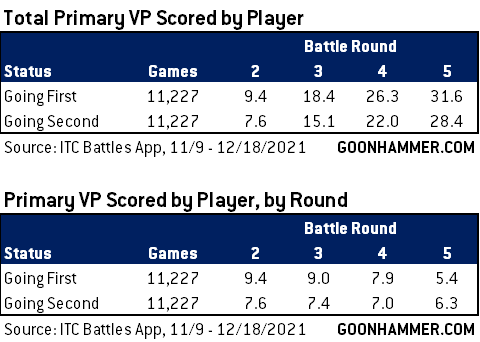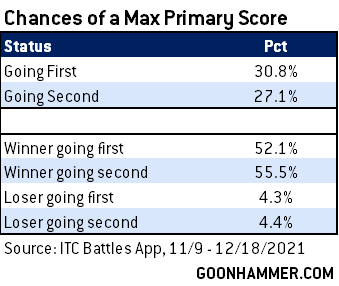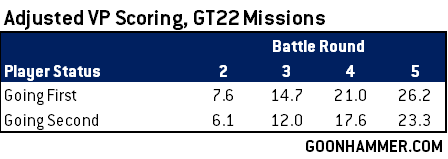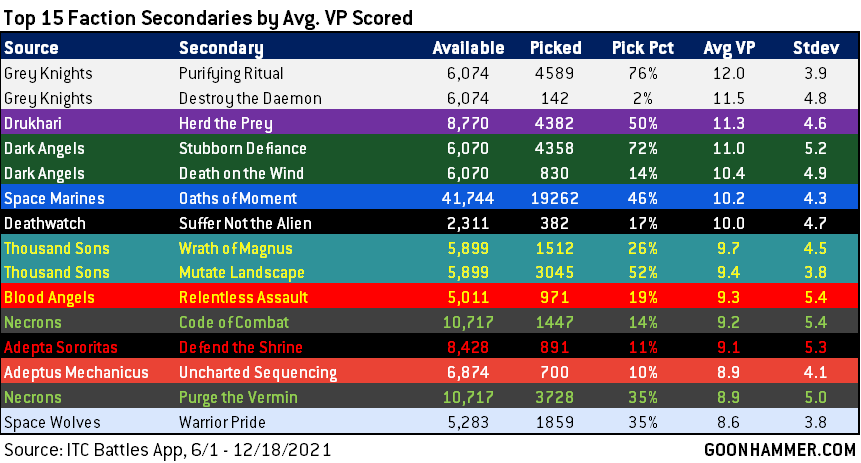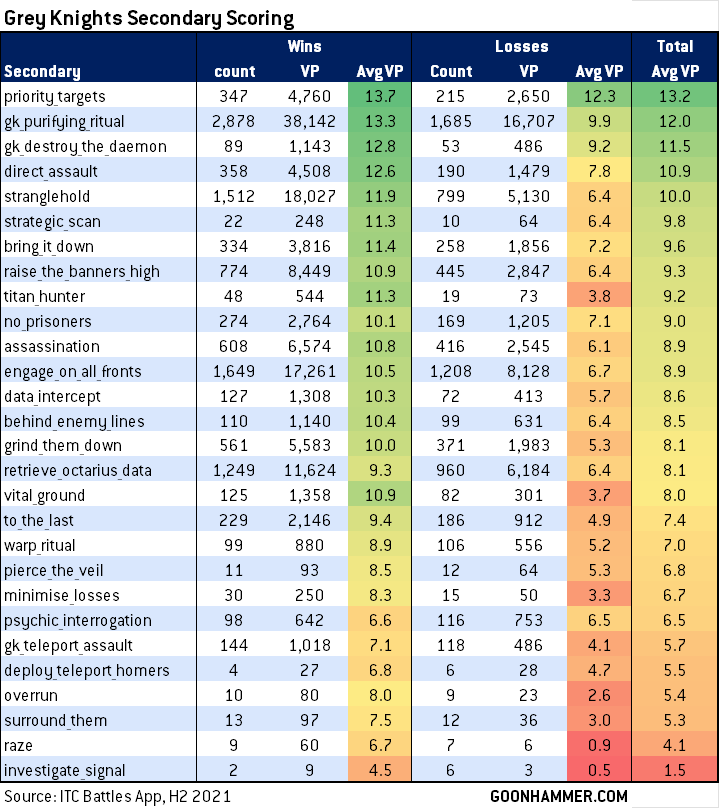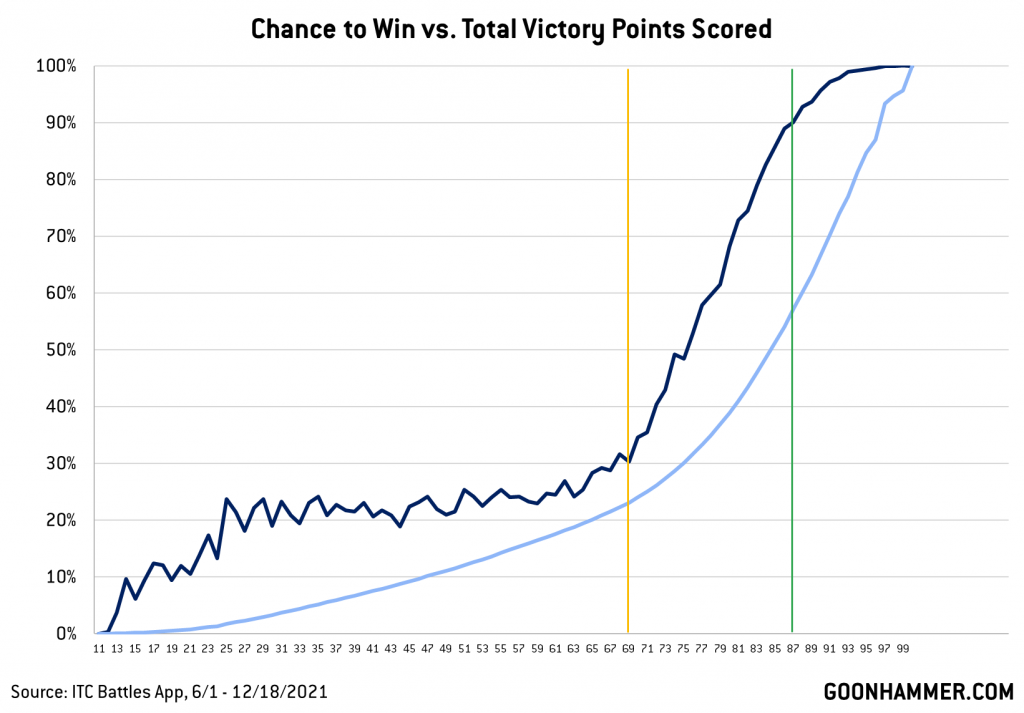Hello again, Dear Reader! I’m filling in for Primaris Kevin this week. We spent the better part of Saturday talking about the 2021 meta and where factions shook out following a full year of 9th edition events and the impact of the various balance changes but I still had some data left over that didn’t fit into the story we were telling. So today I’ve relieved Primaris Kevin of duty and am bringing you some follow up stats on scoring objectives in 2021 and how the GT2022 missions previewed in Grapevine last month may change things.
Primary Objective Scoring
Let’s start by talking about primary objective scoring. Missions in Warhammer 40k’s GT 2021 mission pack have players scoring 5, 10, or 15 points for primary objectives each turn based on the number of objectives they hold and whether they hold more than their opponents. Because the number of objective markers and parameters for scoring primary objectives change by mission, your odds of scoring primary VP or the maximum score of 45 vary significantly by mission.
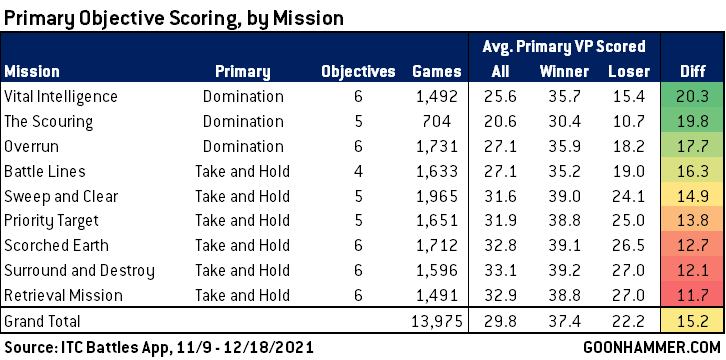 The combination of 6 objectives and only needing to hold one/two to score 5 and 10 VP, respectively, makes for missions where both players are likely to score a large number of VP on primary objectives, pushing down the points differential between players. While requiring a player hold two objectives makes for much higher primary points differentials.
The combination of 6 objectives and only needing to hold one/two to score 5 and 10 VP, respectively, makes for missions where both players are likely to score a large number of VP on primary objectives, pushing down the points differential between players. While requiring a player hold two objectives makes for much higher primary points differentials.
One of the big changes in 2021 GT missions was having the player going second score primary objectives at the end of their turn in the final battle round. On average this translates to a little less than a 1-point advantage, though it appears that going first still conveys a greater point differential in rounds 2 and 3, which may help explain why first turn win rates are still higher in our dataset. In the charts below you can see the average total and by-round primary VP scored by players going first and second.
One of the more interesting outcomes here occurs when we look not just at the average primary scoring for players but how often players in different situations achieve a maximum primary score, i.e. 45 points. And here we can see something interesting: That while going first makes a player a bit more likely to max their primary score overall, players who win going second are more likely to score maximum primary objective points than players who win going first.
The Impact of the 2022 Nachmund Season Missions on Primary Scoring
We’ve already had a clear taste of the new missions coming the first season of competitive 40k, in 2022 – the preview at the GW series finale event in Grapevine showed off two new missions and the new secondary objectives – and one of the most interesting changes to those missions is the removal of mission secondary objectives, to be replaced with bonus primary objectives. In addition, scoring on primary objectives has been adjusted, with scoring moving from 5/10/15 for holding objectives to 4/8/12 with an option for bonus points.
This is an interesting change as, strictly speaking, it means it will be much harder to score the maximum points on a primary objective without also netting those bonus points. On average, only 10% of games see a player scoring maximum primary points before battle round 5, and those are likely to also be the games where a player can max the new primary objectives without scoring bonus points – going into battle round 5 with 36 VP scored on primary objectives means that a fourth consecutive turn of 12-point scoring will net that player just enough to max their primary objective score.
If we adjust primary scoring for the new missions and make a few estimation tweaks – assuming that players who scored 12 every turn on primary in rounds 2-4 will score another 12 on round 5, and taking into account when players are likely to have hit the scoring cap in round 5 – we can revise our per-round scoring averages. The net impact seems to be that while early scoring discrepancies are likely to be smaller – there are, after all, fewer points to be scored now – there are likely to be more primary objective points for the player going first to score on round 5, which could lead to a higher scoring discrepancy on later turns, wiping out the second player’s advantage of scoring at the end of their turn. Now this all comes with the massive caveat that this doesn’t include the bonus points, but it’s worth keeping an eye on – this could be something that swings go-first win rates back above 55% in the next competitive season.
Wings: The alternative possibility (or a second factor that could play alongside this) is that it turns out that scoring the new additional primary conditions is easier for the player going second in the first few turns, and since their total primary score tends to be lower, racking these up will almost always be useful to them. My sense (from the two we’ve seen so far) is that Rob is correct that the additional primary is likely to be easier for the first player in the final battle round, but the player going second still has the objective scoring advantage at that point, and if they go into that turn less far behind, that could help a lot. Certainly something that will be interesting to see play out.
Secondary Objective Scoring
And then there’s the other half of the game. With Primary Scoring set to become more difficult, secondary objectives will almost certainly become more important. That’s great news for factions that have good secondary objectives, and not so great for factions that don’t have secondary objectives, or for whom their options are not so great.
Let’s start by looking at the secondary objectives in the 2021 GT mission pack.
We did a review of the GT 2021 Secondary objectives back in August that looked at changes to secondary scoring based on the “era” of 9th edition. Here are a few things to note:
- On average, GT Secondaries are worth about 8 VP. That hasn’t changed since the GT 2021 mission pack released, and represented about a half-point increase from the 2020 Missions pack. This is probably a mix of the 2021 missions being a bit easier to score, armies being better at scoring them, and players being more used to them.
- Abhor the Witch is now (again) more valuable. Abhor is now worth an average of 10.1 VP. It was worth an average of 9.9 VP in the 2020 pack, where it rewarded more points for killing each psyker, and it slowly became more valuable as Grey Knights, Thousand Sons, and Tyranids have become more common again. This hasn’t really changed the rate at which it’s picked, however – it’s back to 6%, about the same as in 2020, and up from its low of 5%.
- Stranglehold is the game’s best universal secondary objective. Stranglehold gets picked in about one fourth of games where it’s available, and averages 8.8 VP per selection, a clear improvement from the 7.7 Domination used to provide. Engage on All Fronts is the next best universal secondary – and is picked more often (46%), but only averages 8.1 VP and is likely less valuable for many armies, including Drukhari, who will take Herd the Prey instead.
- Retrieve Octarius Data was an effective replacement for Deploy Scramblers. RoD gets picked in 38% of games and is the most consistent of the universal secondary objectives, with a standard deviation of only 3.8 VP. RoD may not let you score 15 but it’s remarkably consistent at getting you 8.
Projecting the GT 2022 Secondary Objectives
With a new set of secondary objectives coming out, we can look at the scoring for those to determine how those changes might affect secondary scoring for the next competitive season.
Bring it Down
One of the biggest changes is to Bring it Down, which now awards players 2 VP for destroying a vehicle or Monster with 10 wounds and 3 VP for destroying a vehicle with 15+. This means it’s likely to be worth more points, as there are a number of vehicles with 10 wounds – such as Drukhari Raiders – that were previously worth 1 VP – and that some larger targets like Mortarion and Be’lakor are suddenly worth 3. In the 2020 GT Missions pack, Bring it Down was a much heftier 2/3 VP for 1-10/11+ wound vehicle/monster targets, and that led to a secondary objective that was taken in 32% of games and worth an average of 9.7 VP. This change doesn’t make the secondary anywhere near as good as its 2020 incarnation, but will likely see the objective getting more use – bringing it up to around 20% usage and an average of 8.5 VP.
No Prisoners
The adjustment to No Prisoners now awards players 1 bonus VP for scoring 50 wounds (5+) and another for scoring 100 wounds (10+), allowing players to max out the secondary much more easily. Looking at existing score data and adding in bonus points where players would have earned it increases the average score for the objective to 8.4, nearly a full point’s worth of improvement from the prior incarnation. In addition, those same players would have maxed out the secondary in 13% of games, compared to only 9% before, an improvement of more than 40%.
Engage on All Fronts and Retrieve Nachmund Data
These secondaries will both become more difficult to score, making them less likely to be picked and less likely to be scored, since they now have stricter requirements for completion. Expect Engage to drop out of the top VP scoring objectives to something more average, and for Retrieve Nachmund Data to drop to something more like 15% pick rate with higher variance, though potentially the same average score.
Psychic Interrogation
After being changed to require Line of Sight, Psychic Interrogation now no longer requires it. We can compare this in part to the old secondary, Mental Interrogation, which did not require Line of Sight but had an 18″ range. The new secondary is better than both but it’s not clear how this will improve it – adding 6″ to range increased average scoring on the secondary from 5.9 to 6.2. We may see that climb further, but expecting anything higher than 7 or even 6.5 seems like a stretch, particularly since the game’s Psychic factions have better options. The secondary has larger issues, like the tension between keeping your targets alive and killing them to win the game.
Wings: I’m a bit more bullish on this one – I think this might finally be the year where this puts up some appeciable results. It’s now much harder to stop this, and we’re also going into an environment where armies can’t fall back on a mission secondary as a middle of the road third selection, so building for this seem more realistic.
Investigate Signal and Deploy Teleport Homers
The tweaks to these are slight, but may see them getting picked more. It’s unlikely the changes will lead to large increases in scoring, but may lead to a decrease in scoring variance, making them more reliable.
Wings: Mostly agree on Homers – it’s much easier, but it’s still going to be true that if you can make it work, you could also be acing something else. Investigate Signal I think has a real chance of breaking out now – the fact that it’s almost always possible where previously your opponent could just shut you out from turn two onwards is a massive difference, and I think armies that have good capacity to hold the centre and poor RND units have to think seriously about pivoting to this.
Faction Secondaries
And then there are the faction secondaries. Most of the game’s factions with a 9th edition codex have access to 3-4 of these, and while the majority are bad, there are a dozen or so that are very, very good, or at least good enough to be reliably chosen as that faction’s third objective, giving them a clear edge over factions without a secondary set to choose from. Let’s look at the top options:
If you’ve followed along with our prior analyses, you’d see that we have a new top dog here – the Grey Knights’ Purifying Ritual is now the game’s strongest Secondary, averaging 12 VP per game and, being entirely enemy-agnostic, shows up in an astonishing 76% of games played by Grey Knights players. That’s pretty brutal.
Next on the list is the old Drukhari standby Herd the Prey, still averaging more than 11 VP per game and showing up in about half of Drukhari games (likely depending on when the opponent is fast enough that a different secondary is called for). and then Dark Angels’ Stubborn Defiance posts similar results at an average of 11 VP and showing up in 72% of Dark Angels games.
On a personal note, I’d like to see any faction secondaries averaging more than 10 VP and 50% usage get adjusted – Drukhari have been nerfed several times now but one of the main culprits in their success is the Herd the Prey secondary objective. Now admittedly some of that is due to how good Drukhari are – the same secondary is only worth 8.9 VP for Necrons, on average, but that too is above average for a secondary objective. My recommendation is to move scoring for it to the end of the Battle Round, at the very least.
I’d also recommend nerfing Purifying Ritual with a VP cap, though in discussing this on our Discord server Innes Wilson brought up that Grey Knights need a way to overcome the VP surrendered to Abhor the Witch in many games. This is a fair point, and something I decided to look at. Specifically, Abhor is taken in about 50% of games against Grey Knights. In those, opponents score an average of… 11.9 VP from Abhor against Grey Knights. That usually ends up being 14 VP in Grey Knights losses and around 10.5 in GK wins. Let’s look at the Grey Knights secondary scoring to compensate for this:
Purifying Ritual is the faction’s best secondary, and Grey Knights score an average of 13.3 VP off it in wins and 9.9 VP in losses, essentially off-setting the VP scored against them from Abhor. This is… upsetting, because it means that Grey Knights depend on having Purifying Ritual against opponents who can’t take Abhor, but then need Purifying Ritual to be an insanely strong secondary to offset the disadvantage from Abhor against opponents who can take it. This also potentially explains why Drukhari have a decent matchup against Grey Knights.
If we compare Grey Knights to the other psychic faction, Thousand Sons only score an average of 9.4 VP per game off Mutated Landscape, and tend to give up an average of 9.5 to opponents on Abhor the Witch. Another point where the two potentially offset, but this also perfectly explains why Thousand Sons have a terrible matchup against Grey Knights, where suddenly they have a larger deficit to overcome.
Scoring and Winning
“Usually the team with the most points wins the game”
– John Madden
Credit to the late, great John Madden for that quote, reminding us that if you want to win the game, you’ve got to score some points. Let’s look at win probability by points scored:
A lot of people like to look at this chart and smugly declare that they already knew that scoring more points was good for your win probability. But there’s more to this than that – this particular chart helps us understand just how many points we need to score in order to win most of our games. Which is important when it comes to planning and testing your army. Specifically, in order to consistently win games, your army needs a plan to score more than 65 points before paint scores are added. And to compete at higher levels, you need a plan to score more than 77 points per game.
This is even more clear when you start looking at top scores at events, where tiebreakers are often dependent on points scored:
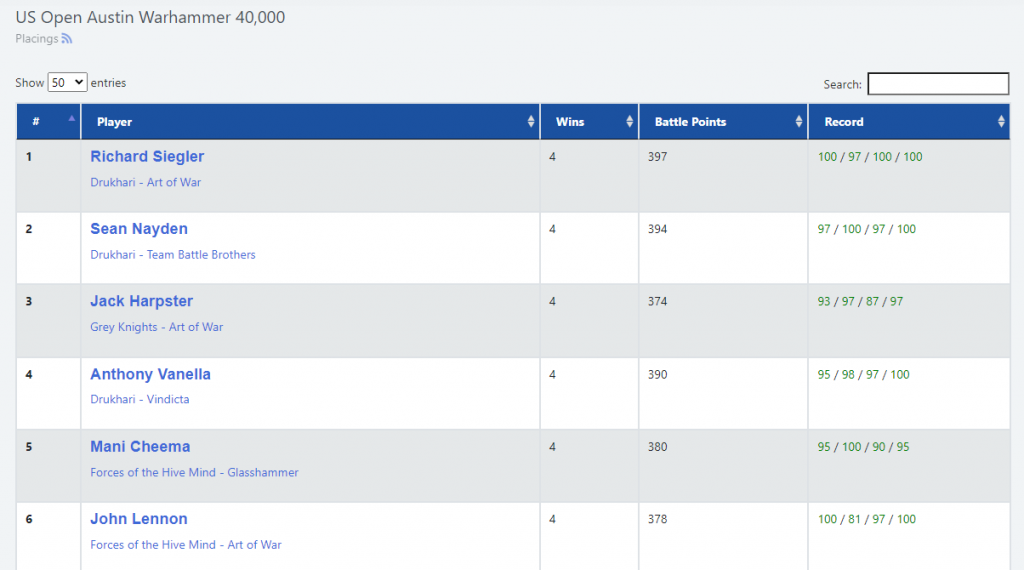
Consider that each of those armies has been built with the potential to reliably score 45 points on secondary objectives, which means not taking Retrieve Octarius Data or any other secondary that caps at fewer than 15 points. The more points your army can score, the less you’ll have to rely on denying your opponent points in order to win (though obviously you should still make every effort).
Alright, that wraps up our look at scoring objectives and how they might change in the next competitive season. As always, if you have any questions or comments feel free to drop us a note in the Comments below or email us at contact@goonhammer.com.

